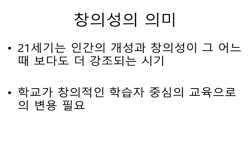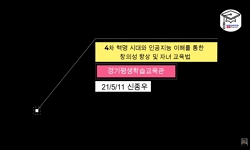The purpose of this study is to explore the meaning and direction of the ‘body expression activity’ in the basic curriculum of special education through an analysis of the contents of the curriculum. For this purpose, analysis of the basic curricu...
http://chineseinput.net/에서 pinyin(병음)방식으로 중국어를 변환할 수 있습니다.
변환된 중국어를 복사하여 사용하시면 됩니다.
- 中文 을 입력하시려면 zhongwen을 입력하시고 space를누르시면됩니다.
- 北京 을 입력하시려면 beijing을 입력하시고 space를 누르시면 됩니다.

특수교육 기본교육과정에서 “신체표현활동”의 의미와 방향 탐색 = Exploration of the meaning and direction of the “Body expression activity” in the basic curriculum of special education
한글로보기https://www.riss.kr/link?id=A100267407
- 저자
- 발행기관
- 학술지명
- 권호사항
-
발행연도
2014
-
작성언어
-
- 주제어
-
KDC
300
-
등재정보
KCI등재
-
자료형태
학술저널
- 발행기관 URL
-
수록면
29-51(23쪽)
-
KCI 피인용횟수
1
- 제공처
-
0
상세조회 -
0
다운로드
부가정보
다국어 초록 (Multilingual Abstract)
The purpose of this study is to explore the meaning and direction of the ‘body expression activity’ in the basic curriculum of special education through an analysis of the contents of the curriculum. For this purpose, analysis of the basic curriculum and concept of body expression activity was conducted, and the problems with the body expression activity in the current curriculum was identified to explore the educational meaning and direction for improvement. The results of this study are as follows. First, the goals of body expression activity in the basic curriculum of special education were divided by grade groups of grades 1-2, grades 3-4, grades 5-6 of the elementary school, grades 1-3 of middle school, and grades 1-3 of the high school. The main contents of the grade-specific curriculum groups consist of sensory activities, experience of the elements and media of the basic movement, formation of body through physical activities such as aerobics and rhythmic gymnastics, and creative activities through understanding and expression of the structure of folk dance, and activities to express its theme. Second, research to establish the basic concepts associated with ‘body expression activity’ as used on the basic curriculum of special education was mainly carried out in the areas of early childhood education, special education, and music education. And its basic concept was being used in the context of ‘expressing feeling and thought through movement’, ‘creative activity, expressive activity’, and ‘education of the components of movement.’ And the educational effect was found in the fact that it has a positive impact on the physical, cognitive, emotional, social, linguistic development, and ultimately it contributes to the holistic human development. Third, in order for the ‘body expression activity’ to establish educational meaning as an art education and to be operated as a more systematic course, the application of the organizing principle based on the movement elements of Laban could be an alternative. Fourth, examination of the significance of creativity education through aesthetic experience, which is the aim of the ‘body expression activity’, suggested that it would be better to understand the aesthetic experience as something to signify ‘recognizing and finding’ rather than as something beautiful as it is understood now so that the aesthetic experience should be shed new light on as a basic principle of creativity education.
참고문헌 (Reference)
1 이해경, "협동적 신체표현활동이 유아의 친사회적 행동에 미치는 영향" 한국교원대학교 대학원 2012
2 교육과학기술부, "특수교육 교육과정(2)"
3 교육과학기술부, "특수교육 교육과정(1)"
4 조유선, "클래식 음악감상을 통한 신체표현활동이 만4세 유아의 정서능력과 신체표현능력에 미치는 영향" 성신여자대학교 대학원 2013
5 배서영, "창의적 신체표현활동이 유아의 공간능력 및 정서지능에 미치는 영향" 전남대학교 대학원 2014
6 서민화, "전래동요를 활용한 신체표현활동이 지적장애아의 창의적 신체표현력 및 정서지능에 미치는 효과" 대구대학교 대학원 2013
7 교육과학기술부, "장애인 등에 대한 특수교육법"
8 원상화, "장애영유아 통합보육을 위한 동작교육의 적용방안에 관한 고찰" 한국발달장애학회 17 (17): 29-49, 2013
1 이해경, "협동적 신체표현활동이 유아의 친사회적 행동에 미치는 영향" 한국교원대학교 대학원 2012
2 교육과학기술부, "특수교육 교육과정(2)"
3 교육과학기술부, "특수교육 교육과정(1)"
4 조유선, "클래식 음악감상을 통한 신체표현활동이 만4세 유아의 정서능력과 신체표현능력에 미치는 영향" 성신여자대학교 대학원 2013
5 배서영, "창의적 신체표현활동이 유아의 공간능력 및 정서지능에 미치는 영향" 전남대학교 대학원 2014
6 서민화, "전래동요를 활용한 신체표현활동이 지적장애아의 창의적 신체표현력 및 정서지능에 미치는 효과" 대구대학교 대학원 2013
7 교육과학기술부, "장애인 등에 대한 특수교육법"
8 원상화, "장애영유아 통합보육을 위한 동작교육의 적용방안에 관한 고찰" 한국발달장애학회 17 (17): 29-49, 2013
9 박은진, "유아 신체표현활동의 실태 및 문제점에 대한 교사의 인식" 경성대학교 대학원 2014
10 김태주, "신체표현활동이 유아의 창의성에 미치는 영향" 충북대학교 대학원 2013
11 박주희, "신체표현활동을 통한 창의적인 교수-학습지도안 연구" 목포대학교 대학원 2012
12 박혜향, "신체표현활동을 적용한 음악 감상수업이 자폐성 장애학생의 음악적 능력에 미치는 영향" 경인교육대학교 교육전문대학원 2014
13 김혜원, "신체표현활동 수업 참여 아동의 자아존중감과 또래애착, 행복감의 관계" 공주대학교 대학원 2013
14 남미연, "신체표현을 활용한 유아음악극 지도방안 연구 : 해금독주곡 「계명곡」 중심으로" 중앙대학교 대학원 2012
15 김영란, "신체표현 활동을 통한 창의적 표현능력 신장 방안 : 통합교과 즐거운 생활 2학년을 중심으로" 경인교육대학교 대학원 2014
16 강 진, "신체 및 표현 활동 중심의 실외놀이가 유아의 자기효능감, 기초체력, 사회적 능력에 미치는 영향" 원광대학교 대학원 2013
17 박윤정, "스토리텔링을 활용한 신체표현활동이 유아의 놀이성에 미치는 영향" 인천대학교 대학원 2014
18 이유훈, "발달장애학생을 위한 학교중심 통합교육과 정의 편성과 운영에 관한연구" 국립특수교육원 2001
19 강상희, "미적 경험을 기반으로 한 음악 교육의 창의성 신장 가능성 탐색" 학습자중심교과교육학회 13 (13): 325-343, 2013
20 남기원, "만 3세 유아를 위한 신체표현 연계 과학교육프로그램 개발 및 적용효과" 중앙대학교 2013
21 정재연, "동시를 활용한 신체표현 중심의 언어지도가 경도 지적장애 아동의 은유이해 개선에 미치는 영향" 대구대학교 대학원 2012
22 원상화, "독일예술심리치료의 발전 동향과 한국예술심리치료 발전을 위한 제언" 한국예술심리치료학회 5 (5): 1-21, 2009
23 김미연, "다문화적 접근에 의한 신체표현활동이 유아의 조망수용능력에 미치는 효과" 계명대학교 유아교육대학원 2012
24 송지은, "그림책을 활용한 신체표현활동이 ADHD 유아의 정서지능에 미치는 영향" 대구대학교 대학원 2014
25 Wolfensberger, Giorgio J., "Suzanne Perrottet. Ein bewegtes Leben" Quadriga 1995
26 "Kreativität, Die freie Enzyklopaedie(Wikipedia)"
27 Kugler, M., "Elementarer Tanz-Elementare Musik: Die Guenther-Schule Muenchen 1924 bis 1944" Schott 2002
28 Kugler, M., "Die Methode Jaques-Dalcroze und das Orff-Schulwerk, Elementare Musikuebung" Lang 2000
29 Guenther, D., "Der Tanz als Bewegungsphaenomen" Rowohlt 1962
30 Barck, K., "Aesthetische Grundbegriffe. Bd. 1 Absenz-Darstellung" Metzler 2000
31 정동윤, "2010년 개정 특수교육 교과과정(총론)의 이해"
동일학술지(권/호) 다른 논문
-
생태환경 사회 커뮤니티댄스에서 공동체와 전인교육의 의미
- 한국무용교육학회
- 한혜리 ( Hea Ree Han )
- 2014
- KCI등재
-
- 한국무용교육학회
- 오레지나 ( Regina Oh )
- 2014
- KCI등재
-
- 한국무용교육학회
- 탁지현 ( Jee Hyun Tark )
- 2014
- KCI등재
-
KMP의 「Tension flow rhythms」를 적용한 유아율동심리교육 프로그램 모형개발
- 한국무용교육학회
- 김인숙 ( In Sook Kim )
- 2014
- KCI등재
분석정보
인용정보 인용지수 설명보기
학술지 이력
| 연월일 | 이력구분 | 이력상세 | 등재구분 |
|---|---|---|---|
| 2027 | 평가예정 | 재인증평가 신청대상 (재인증) | |
| 2021-01-01 | 평가 | 등재학술지 유지 (재인증) |  |
| 2018-01-01 | 평가 | 등재학술지 유지 (등재유지) |  |
| 2015-01-01 | 평가 | 등재학술지 유지 (등재유지) |  |
| 2011-01-01 | 평가 | 등재학술지 선정 (등재후보2차) |  |
| 2010-01-01 | 평가 | 등재후보 1차 PASS (등재후보1차) |  |
| 2009-01-01 | 평가 | 등재후보 1차 FAIL (등재후보1차) |  |
| 2008-01-01 | 평가 | 등재후보학술지 유지 (등재후보1차) |  |
| 2007-01-01 | 평가 | 등재후보학술지 유지 (등재후보1차) |  |
| 2006-01-01 | 평가 | 등재후보학술지 유지 (등재후보1차) |  |
| 2005-01-01 | 평가 | 등재후보학술지 유지 (등재후보1차) |  |
| 2003-01-01 | 평가 | 등재후보학술지 선정 (신규평가) |  |
학술지 인용정보
| 기준연도 | WOS-KCI 통합IF(2년) | KCIF(2년) | KCIF(3년) |
|---|---|---|---|
| 2016 | 0.63 | 0.63 | 0.65 |
| KCIF(4년) | KCIF(5년) | 중심성지수(3년) | 즉시성지수 |
| 0.7 | 0.74 | 0.818 | 0.24 |




 KCI
KCI KISS
KISS






